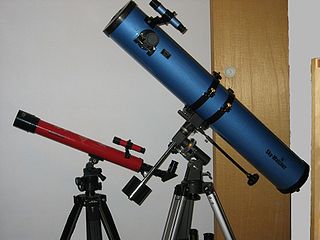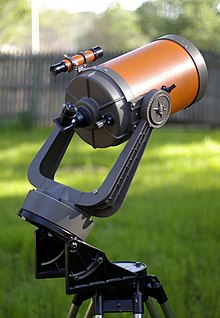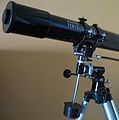
Astrophotography, also known as astronomical imaging, is the photography or imaging of astronomical objects, celestial events, or areas of the night sky. The first photograph of an astronomical object was taken in 1840, but it was not until the late 19th century that advances in technology allowed for detailed stellar photography. Besides being able to record the details of extended objects such as the Moon, Sun, and planets, modern astrophotography has the ability to image objects outside of the visible spectrum of the human eye such as dim stars, nebulae, and galaxies. This is accomplished through long time exposure as both film and digital cameras can accumulate and sum photons over long periods of time or using specialized optical filters which limit the photons to a certain wavelength.
The Meade Instruments is an American multinational company headquartered in Watsonville, California, that manufactures, imports, and distributes telescopes, binoculars, spotting scopes, microscopes, CCD cameras, and telescope accessories for the consumer market. It is the world's largest manufacturer of telescopes.

The Maksutov is a catadioptric telescope design that combines a spherical mirror with a weakly negative meniscus lens in a design that takes advantage of all the surfaces being nearly "spherically symmetrical". The negative lens is usually full diameter and placed at the entrance pupil of the telescope. The design corrects the problems of off-axis aberrations such as coma found in reflecting telescopes while also correcting chromatic aberration. It was patented in 1941 by Soviet optician Dmitri Dmitrievich Maksutov. Maksutov based his design on the idea behind the Schmidt camera of using the spherical errors of a negative lens to correct the opposite errors in a spherical primary mirror. The design is most commonly seen in a Cassegrain variation, with an integrated secondary, that can use all-spherical elements, thereby simplifying fabrication. Maksutov telescopes have been sold on the amateur market since the 1950s.

The Cassegrain reflector is a combination of a primary concave mirror and a secondary convex mirror, often used in optical telescopes and radio antennas, the main characteristic being that the optical path folds back onto itself, relative to the optical system's primary mirror entrance aperture. This design puts the focal point at a convenient location behind the primary mirror and the convex secondary adds a telephoto effect creating a much longer focal length in a mechanically short system.

Hamburg Observatory is an astronomical observatory located in the Bergedorf borough of the city of Hamburg in northern Germany. It is owned and operated by the University of Hamburg, Germany since 1968, although it was founded in 1825 by the City of Hamburg and moved to its present location in 1912. It has operated telescopes at Bergedorf, at two previous locations in Hamburg, at other observatories around the world, and it has also supported space missions.
Orion Telescopes & Binoculars is an American retail company that sells telescopes, binoculars and accessories online and in-store for astronomy and birdwatching. It was founded in 1975 and has corporate offices in Watsonville, California. A large proportion of its products are manufactured by the Chinese company Synta for the Orion brand name. Orion Telescopes & Binoculars ships its products to the United States and over 20 other countries. Orion puts out a semi-quarterly mail-order catalog as well as email catalogs. The company is a prominent advertiser in North American astronomy magazines, such as Sky & Telescope and Astronomy.

The El Leoncito Astronomical Complex is an astronomical observatory in the San Juan Province of Argentina. CASLEO is one of two observatories located within El Leoncito National Park, which is in a part of the country which rarely sees cloud cover. The other facility in the park is the Carlos U. Cesco Astronomical Station of the Félix Aguilar Observatory. CASLEO was established in 1983 by an agreement between National Scientific and Technical Research Council (CONICET) of Argentina, the Ministry of Science, Technology and Innovation (MINCYT) of Argentina, the National University of San Juan (UNSJ), the National University of La Plata (UNLP), and the National University of Córdoba (UNC). The facility was dedicated in 1986 and regular observations began in 1987.

The ETX is a line of smaller aperture telescopes made by Meade Instruments.
Tasco sells consumer telescopes. Tasco mainly imports telescopes for amateur astronomers but has expanded into other optical products, such as spotting scopes, microscopes, binoculars, telescopic sights, and other rifle accessories. Tasco sells via retail stores, catalogs, and online retailers. Tasco is based in Miramar, Florida. George Rosenfield founded the firm as the Tanross Supply Company in 1954. It started as a distributor of fishing tackle and hardware. The name was later shortened to Tasco as its offerings expanded to include binoculars and eyepieces.

Sky-Watcher is a commercial distribution company established in 1999 by the Synta Technology Corporation of Taiwan. It markets telescopes and astronomy equipment, such as mounts and eyepieces, aimed at the amateur astronomy market. The products are manufactured at Synta Taiwan's Suzhou Synta Optical Technology Co., Ltd. in Suzhou (Jiangsu), China. The brand is distributed in Canada, Europe and in the late 2000s, it was extended to the United States market.

The Heights Observatory is an Astronomical Observatory at The Heights School in Modbury Heights, Adelaide, South Australia.

Observatory Robert A. Naef is an astronomical observatory located at Épendes, Canton of Fribourg, Switzerland at 7.13938 degrees east of Greenwich and 46.76236 degrees north latitude. Its parallax constants are : ρ sin φ' = 0.68632 and ρ cos φ' = +0.72501.
The SUNY Oneonta Observatory is an astronomical observatory in Oneonta, New York, home to the state's largest optical telescope and one of the largest publicly open east of the Mississippi, a one-meter Newtonian reflector constructed by JMI Telescopes of Lakewood, Colorado.
The Whakatane Astronomical Society is a voluntary, non-profit society for people interested in amateur astronomy in the Whakatane District of New Zealand. The society was founded in September 1960, and maintains a small observatory in Whakatane, which has been operating continuously since 1964. The society is affiliated with the Royal Astronomical Society of New Zealand.

The Meade LX200 is a family of commercial telescopes produced by Meade Instruments launched in 1992 with 8" (20.32 cm) and a 10" (25.4 cm) Schmidt–Cassegrain models on computerized altazimuth mounts. Two larger models, a 12" (30.48 cm) and a 16" (40.64 cm), quickly followed. The original version was later informally named the "classic" LX200 as newer upgraded versions replaced it. The first of these was the LX200GPS, which featured global positioning system electronics. A 360 mm (14 in) LX200GPS was later added to the line.
Thomas Jasper Johnson or Tom Johnson was an American electronics engineer and astronomer who founded Celestron, a company which manufacturers telescopes, which revolutionized the amateur astronomy industry and hobby. Sky & Telescope magazine has called him, "among the most important figures shaping the last half century of amateur astronomy."
Suzhou Synta Optical Technology Co., Ltd. is a Chinese company located in Suzhou, Jiangsu, China, the primary manufacturing subsidiary of Synta Technology Corporation of Taiwan. It produces telescopes and astronomical equipment like mounts and eyepieces for the amateur astronomical market.
Synta Technology Corporation of Taiwan, also known as Synta, is a manufacturer of telescopes and optical components headquartered in Taoyuan, Taiwan.
Astro-Physics, Inc. is a manufacturer of amateur telescopes, mounts, and accessories. Founded in 1975 by former Sundstrand Corporation engineer Roland Christen, the company is noted for its line of apochromatic refractors as well as high-end mounts. The company is located in Machesney Park, Illinois.

Hereford Arizona Observatory (HAO), IAU-code G95, is an astronomical observatory, owned and operated by amateur astronomer Bruce L. Gary. Observational studies of unusual starlight fluctuations in Tabby's Star and WD 1145+017 are recent interests.


















